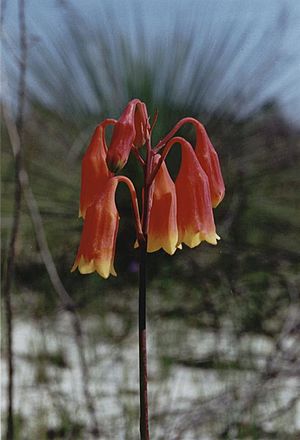Large Christmas bell facts for kids
Quick facts for kids Christmas bells |
|
|---|---|
 |
|
| Blandfordia grandiflora Brisbane Water National Park |
|
| Conservation status | |
|
Endangered (NCA)
|
|
| Scientific classification | |
| Genus: |
Blandfordia
|
| Species: |
grandiflora
|
| Synonyms | |
|
|
Blandfordia grandiflora, often called Christmas bells, is a beautiful flowering plant that grows only in eastern Australia. It's a type of perennial herb, meaning it lives for more than two years and has soft stems. This plant forms clumps with long, narrow leaves. It produces between two and twenty large, bell-shaped flowers that hang downwards. These flowers are usually red with yellow tips, but sometimes they are completely yellow.
Christmas bells are one of four types of Blandfordia plants. This specific kind grows along the coast and in nearby mountain ranges. You can find it from Sydney in New South Wales all the way up to Fraser Island in Queensland.
Contents
What Do Christmas Bells Look Like?
Blandfordia grandiflora is a plant that grows in clumps. It has flat, narrow leaves that are usually up to 80 centimeters (about 31 inches) long and 7 millimeters (about 0.3 inches) wide.
The Flowering Stem
The stem that holds the flowers is usually unbranched. It can grow up to 80 centimeters (about 31 inches) long and about 7 millimeters (about 0.3 inches) wide. Some stems can even reach up to 175 centimeters (about 69 inches) long!
The Flowers
Each plant can have between two and twenty flowers. Each flower hangs on a small stalk called a pedicel, which can be up to 45 millimeters (about 1.8 inches) long. There's also a tiny leaf-like part called a bract near the base of each stalk.
The flower itself is bell-shaped. It's made up of three sepals and three petals that are joined together. The flower is usually 35 to 60 millimeters (about 1.4 to 2.4 inches) long and about 18 to 30 millimeters (about 0.7 to 1.2 inches) wide at the top. The bottom part of the flower is narrow, then it slowly gets wider towards the tip. At the tip, there are six pointed parts, each about 11 millimeters (about 0.4 inches) long.
Most of the time, the flowers are red with yellow tips, but sometimes they are all yellow. Inside the flower, the stamens (which produce pollen) are attached to the inner wall, just below the middle.
When Do They Flower?
Christmas bells usually bloom from late spring to early summer. After the flowers, the plant produces a fruit called a capsule. This capsule is about 60 millimeters (about 2.4 inches) long and sits on a stalk that can also be up to 60 millimeters long.
How Christmas Bells Got Their Name
The plant Blandfordia grandiflora was first described in 1810 by a botanist named Robert Brown. He found samples of the plant near the Hunter River.
Meaning of the Name
The name Blandfordia was chosen to honor the Marquis of Blandford. The second part of the name, grandiflora, comes from two Latin words: grandis, which means "great," and -flora, which means "flowered." So, grandiflora basically means "large-flowered."
Where Do Christmas Bells Grow?
This type of Christmas bells plant likes to grow in damp soils. You can find it along the coast and in the tablelands (flat, elevated areas) of eastern Australia. Its range stretches from the Hawkesbury River in New South Wales up to Fraser Island in Queensland. It can also be found inland as far as Glen Innes.
Growing Christmas Bells at Home
Even though Blandfordia grandiflora is native to Australia, people in Great Britain grew it in pots back in the 1800s. This shows that it's a plant that can be grown outside of its natural habitat.
What They Need to Grow Well
Christmas bells grow best in sandy soils. The wet coastal areas of Australia, like those in New South Wales and Queensland, have the perfect sandy soil for them. The soil should be light and drain water well.
It's also important that the plant doesn't get too much direct sunlight or too much heavy shade. Even though B. grandiflora is the strongest of the four Christmas bells species, it grows very slowly. Because of this, other faster-growing plants can easily take over its space in the wild.
Christmas Bells in Culture
This beautiful plant has even been featured on Australian stamps! It appeared on stamps issued in 1960 and again on Christmas stamps in 1967.
Images for kids




